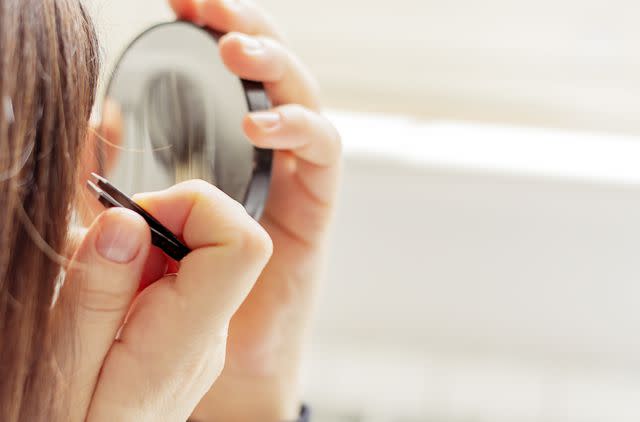Pulling Out Eyelashes
Medically reviewed by Michael MacIntyre, MD
Pulling out your eyelashes can be a symptom of various conditions, including anxiety, obsessive-compulsive disorder (OCD), or trichotillomania. You may find the urge to pull out your hair overwhelming, and once the hair is pulled out, you feel relief. In this sense, it’s a compulsion.
Your eyelashes help keep dirt and dust out of your eyes, so not having eyelashes makes the eye vulnerable to possible complications. Pulling out the eyelashes can also lead to irritation and infection, so getting help is important.
This article will review the symptom of pulling out eyelashes and the causes and treatment options.

rarrarorro / Getty Images
Signs Someone is Pulling Out Their Eyelashes
Your eyelash-pulling behavior may become noticeable by others when you lack lashes. A healthcare provider may also make this observation during an exam.
You may have an uncontrollable urge to pull out your eyelashes or do it without thinking about it. You may feel a sense of relief after pulling the eyelashes out. Or, you may have increased tension when trying to avoid pulling out the hair.
The hair-pulling may be ritualistic behavior, for instance, you pull it out in a specific way or search for a certain kind of hair. Attempts to hide the lack of eyelashes might also be made, like wearing false eyelashes.
Why People May Pull Out Eyelashes
Trichotillomania is a common cause of pulling out eyelashes. This is a body-focused repetitive behavior in which a person pulls out their hair. It is an impulse control disorder and is sometimes classified as a type of obsessive-compulsive disorder (OCD).
Pulling out hair or eyelashes can also be brought on by severe stress or anxiety. A person may not have the coping mechanisms to handle these feelings, so they may turn to hair-pulling.
Medical Reasons for Missing Eyelashes
Eyelash hairs may be missing due to a medical cause. Certain disorders can cause hair to fall out. This includes alopecia areata (an immune system disorder leading to hair loss), as well as other forms of alopecia (hair loss). Chemotherapy cancer treatments also can cause eyelash loss.
Related: What to Do If You Lose Your Eyelashes During Chemotherapy
Treatments to Help Stop Pulling Out Eyelashes
To treat someone who pulls out their eyelashes, an evaluation would need to be made by a mental health provider or other healthcare provider familiar with the condition. This evaluation will determine the correct underlying cause.
Having trichotillomania is often the reason for pulling out hair, but screening for other conditions is important to determine treatment. If trichotillomania is the cause, behavioral therapy is often effective.
Behavioral therapy involves becoming aware of triggers that set off the behavior and then changing the behavior. Habit-reversal training is particularly effective for pulling out hair. Interpersonal therapy to work on self-esteem and daily functioning might also help.
Medications such as selective serotonin reuptake inhibitors (SSRIs) can be beneficial. If medication is decided upon, it should be supervised by a psychiatrist with expertise in OCD and related disorders.
SSRIs can take up to six weeks at a therapeutic dose to become effective. If the medication does not help at all, it should be discontinued.
SSRI medications used can include:
Anafranil (clomipramine)
Paxil (paroxetine)
Prozac (fluoxetine)
Zoloft (sertraline)
Other medications that might be used include:
What Is Latisse?
Latisse (bimatoprost) is a prescription medication used to treat people with no or few eyelashes. It was approved by the Food and Drug Administration in 2008 for certain hypotrichosis conditions, including children who completed chemotherapy. Healthcare providers do use it off-label for cosmetic reasons, but it won't treat the underlying cause of your hair pulling behaviors.
Related: Do Eyelashes Grow Back?
Complications Associated With Pulling Out Eyelashes
Eyelashes protect the eyes from dust, dirt, and sun. Without that natural protection, the eyes are more vulnerable to elements or debris.
Complications of pulling out one’s eyelashes can include:
Skin infections or irritation where the hair is pulled out
Eye problems due to the lack of protection from dust, sun, or debris
Despite their utility, eyelashes have a cosmetic function for many people. You may feel self-conscious about how your eyes look and worry about eyelashes growing back. One study of people with breast cancer who lost eyelashes to chemotherapy found 46% of them had most of their eyelashes back within a year. Your healthcare provider can help you know what to expect.
Experts find that some people face ridicule due to missing eyelashes. They may want to consider exposure therapy to help them prepare for these situations while in a safe, controlled setting.
When to See a Healthcare Provider
Talk with a healthcare provider if you are pulling out your eyelashes or any other hair. They can refer you to a mental health provider who specializes in OCD spectrum disorders or anxiety disorders. Without treatment, the behavior is likely to continue.
Summary
Pulling out eyelashes can signal an underlying anxiety or obsessive-compulsive disorder. It can cause eye problems or complications. Pulling out eyelashes can be a symptom of trichotillomania but can also be brought on by stress.
Without treatment, the behavior will likely continue. It is treatable with behavioral therapies. Sometimes, medication also is prescribed.
Read the original article on Verywell Health.

